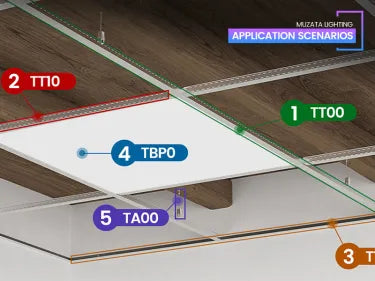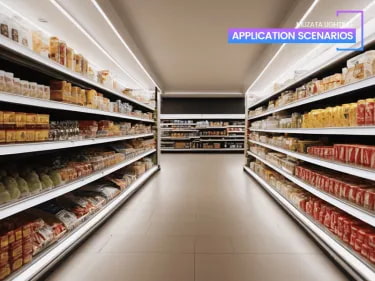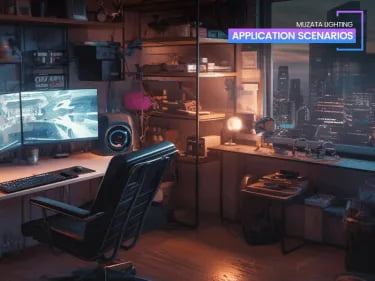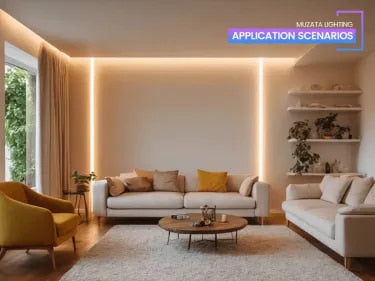TABLE OF CONTENTS
Can I Put LED Lights on Drywall?
OF COURSE! You can put LED lights on drywall. LED lights can be installed on materials with the following properties: good heat dissipation, fire resistance, durability and aesthetic appeal.

Why Drywall Are Suitable For LED Lights Installation?
Dry walls typically provide strong and stable support, capable of bearing the weight of LED lights. LED lights would produce some heat, dry walls offer good insulation, effectively isolating electrical components and conductors, thereby reducing electrical safety risks.
Compared to damp or soft walls, dry walls are easier to drill into, secure, and install LED lights, ensuring firm and stable installations. What's more, LED lights installed on dry walls are less susceptible to the impact of moisture, maintaining the aesthetic appeal of both the wall and the light fixture.
Other Materials Suitable For LED Lights Installation
LED lights can be installed on a variety of materials, in addition to drywall, there are various other materials suitable for installing LED lights. Here are some examples:
-
Wood
Wood surfaces, such as wooden beams, panels, or furniture, can be ideal for installing LED lights. Wood provides a natural and warm aesthetic and can easily support the installation of LED strips or fixtures.
-
Metal
Metals like aluminum are often used for mounting LED light fixtures due to their durability and heat dissipation properties. Aluminum extrusions are commonly used for creating custom LED lighting solutions.

Muzata V-Shaped LED Aluminum Channel System
-
Plastic
Certain types of plastic materials, such as acrylic or polycarbonate, are suitable for diffusing and protecting LED lights. They are often used for making light panels or diffusers.
-
Glass
Glass surfaces can provide a sleek and modern look for LED installations. LED lights can be integrated into glass shelves, countertops, or display cases to create a sophisticated lighting effect.
-
Concrete
In industrial or contemporary settings, concrete surfaces can serve as a unique backdrop for LED lighting. Concrete walls, floors, or fixtures can be used to mount LED lights for a modern aesthetic.
-
Fabric and Textiles
LED lights can be embedded in fabric or textile materials to create soft, diffused lighting effects. This is often used in decorative applications such as backlit signage or accent lighting.
-
Outdoor Materials
For outdoor applications, materials such as weather-resistant plastics, aluminum, stainless steel, and treated wood are suitable for mounting LED lights to withstand exposure to the elements.
Choosing the material that is compatible with the specific type of LED fixture being used, and combined with proper installation methods, you can have a LED lights with long life-span and use them safely and happily.
What Makes Firm And Stable Installation

When installing LED lights, it is crucial to select fixtures that are appropriate for the specific location and intended purpose. Opt for high-quality fixtures that can withstand the environmental conditions of the installation area, such as moisture or temperature fluctuations.
Securely mount the fixtures using a suitable method, such as screws, brackets, clips, or adhesive options, following the manufacturer's instructions. Ensure that the mounting surface is strong enough to support the weight of the fixtures and reinforce it if necessary.

Muzata 12 Pack Caps and Mounting Clips
Properly manage the wiring, using clips, channels, or conduits to avoid strain or tension on the lights and protect the wires from sharp edges or moving parts. Make sure all electrical connections are secure and adhere to local codes, checking wire connections, terminals, and junction boxes for any loose connections.

Muzata Spotless LED Aluminum U Channel
Test the lights after installation to ensure they are functioning correctly, and inspect for any signs of instability or looseness. Regularly maintain the lights by checking for wear, loose connections, or damage, and clean them to prevent dust or debris buildup that could affect their performance.
Other Considerations For LED Lights Installation?
Planning
Before starting the installation, plan the layout and placement of the LED lights. Consider factors such as the desired lighting effect, the location of power sources, and the type of surface or structure where the lights will be mounted.
SAFETY FIRST!
Ensure that the power is turned off before working with any electrical connections. Use appropriate safety gear, such as gloves and goggles, when handling tools or working at heights.
Measure and Mark
Take accurate measurements and mark the positions where the LED lights will be installed. This will help ensure proper alignment and spacing.
Adequate Ventilation
LED lights generate heat, so ensure that there is sufficient ventilation around the fixtures. Avoid installing LED lights in enclosed spaces without proper airflow, as excessive heat can affect their performance and lifespan.
If you are unsure about any aspect of the installation, it is advisable to consult or hire a professional electrician or lighting specialist for guidance and assistance.
ABOUT THE AUTHOR





